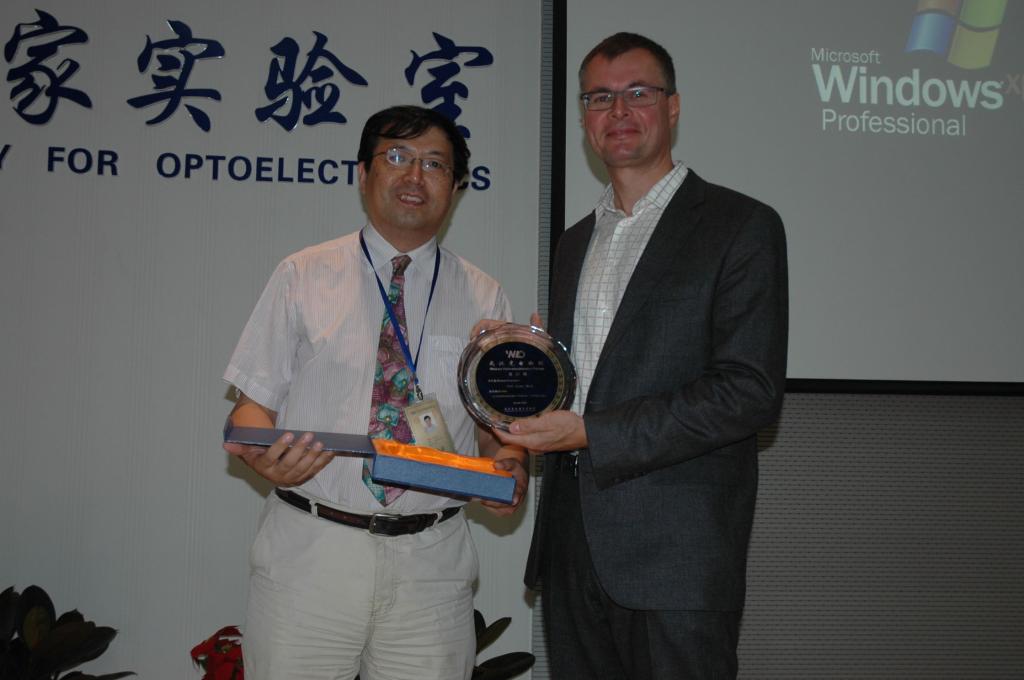2009年9月28日下午4点,丹麦工程院院士,丹麦技术大学光子工程系纳米光子学部主任Jesper Mørk教授做客武汉光电论坛第27期,做了一场题为“ 快光和慢光——物理本质和实际应用”的精彩报告,武汉光电国家实验室主任助理张新亮教授主持了本次论坛,武汉光电国家实验室副主任谢长生教授、黄德修教授、孙军强教授以及来自光电子学院和武汉光电国家实验室的200余名师生参加了本次论坛。
Mørk教授首先深入浅出地以著名的“ 自行车光速实验”(1999年发表于《自然》杂志上)拉开了本次论坛的序幕。该实验研究人员成功地将光速(群速度)从3×108m/s降至17m/s(类似于一个优秀运动员的自行车骑行速度),将光速减慢了约七个数量级。然而为了获得如此惊人的结果,该实验使用了复杂的原子冷冻装置,所以此方案离商用要求差距甚远。
接下来Mørk教授阐释了光速的几种定义,并介绍光速控制的两种基本机制,即相干布居振荡和电磁诱导透明现象。特别的,Mørk教授指出这里讨论的光速快慢是针对群速度而言,即光包(信息)传播的速度,因此并不违反光速不能被超越一说。Mørk教授介绍说,光速控制技术有着广泛的应用,包括光通信领域亟待解决的光缓存技术、微波光子学领域的相控阵列天线(相控雷达)、微波滤波器等等。
针对相干布居振荡机制,Mørk教授课题组提出两种微波相移器方案。一种是级联多个半导体光放大器和电吸收调制器方案;另一种是级联半导体光放大器和光学滤波器方案。同基于单个半导体光放大器或电吸收调制器的方案相比,第一种方案能有效增加获得的总相移。该方案还巧妙地利用了半导体光放大器对输出信号的强度调制与电吸收调制器的作用相反这一特点有效的降低了对输入信号的强度调制。另外,由于该方案基于半导体器件,因此具有较好的集成前景。第二种方案能够更加有效的增加输出的相移,在实验上实现了20GHz可调谐360°微波相移器。但后一种方案也存在一些局限,如滤波器带来的功率衰减降低了输出信号的信噪比。针对电磁诱导透明机制,该课题组提出一种将量子点与光子晶体耦合实现慢光效应的方案。模拟结果表明,光子晶体的使用能够大大提高慢光效应。
Mørk教授的报告引起了在座师生的浓厚兴趣,在演讲结束后,学生和老师对Mørk教授提出了很多问题,Mørk教授都耐心地一一回答了听众们的提问。最后本次论坛在热烈友好的气氛中结束。
报告人简介:
Jesper Mørk教授分别于1986、1988和2003年获得丹麦技术大学(Technical University of Denmark)硕士、博士和国家博士学位,2002年起任丹麦技术大学光子系正教授。2008年出任光子工程系纳米光子学部主任。
Jesper Mørk教授是1994丹麦光学协会年奖获得者,2006年丹麦Kai Hansen基金获得者,丹麦技术产业部委员,丹麦工程院院士,美国光学学会科学工程理事成员,激光光电子会议(CLEO)、激光光电子会议-欧洲(CLEO-Europe)、欧洲光学学会年会、美国光学学会年会“ 前沿光学” 、美国光学学会主题会议“ 光放大器及其应用”等大会委员会委员,美国光学学会光学放大器技术组副主席(03~04)、主席(05~06),主席(2005),国际光学工程协会(东部)有源及无源光学器件大会合作主席(2005,2006),美国光学学会快慢光会议大会主席(2008)。目前担任量子电子学杂志副主编,光学快报、量子电子学、量子电子学选题杂志、光波技术、光子技术快报、光学快递、物理评论、应用物理评论等国际高水平杂志审稿人,在同行审稿的国际高水平期刊和会议上发表文章330余篇。Jesper Mørk教授主持多项千万以上在研项目,其研究方向是器件物理,特别致力于纳米光子器件、用于全光信号处理的超快器件、慢光、非线性器件的噪声及量子光子学等方向的研究。
Wuhan Optoelectronics Forum 27
Slow and fast light in semiconductor devices: Physics and applications
Abstract
We discuss the physics and possible applications of slow and fast light phenomena in semiconductor waveguides. In particular the effects of coherent population oscillations and electromagnetically induced transparency in semiconductor waveguides are introduced, and the possibilities and limitations due to the properties of the semiconductor material are analyzed. Based on recent experimental results it appears that light speed control by coherent population oscillations may find applications in the field of microwave photonics.
Speaker
Jesper Mørk
DTU Fotonik, Technical University of Denmark
Email: jesm@fotonik.dtu.dk
Jesper Mørk received the MS, PhD and Dr. Techn. degrees from the Technical University of Denmark (DTU), Lyngby, in 1986, 1988 and 2003, respectively. Since 2002, he has been a Professor with DTU Fotonik, Dept. of Photonics Engineering (formerly known as COM). He is the winner of Annual Prize of the Danish Optical Society in 1994 for contributions to the theoretical modelling of semiconductor lasers and the understanding of ultrafast carrier dynamics in semiconductor waveguides. He is also the winner of The “ DANA LIM” award 2006. The award is given by “ Kai Hansen’s Foundation”, the owner of the company “ DANA LIM A/S”. The award (DKK 400.000,-) is given for JM’s research contributions within semiconductor devices for optical communication systems. He is a member of Member of the Danish Research Council for Technology and Production (1.08.2006 – 31.07.2010); member of the Danish Academy of Technical Sciences (ATV); from 2005; Member of the Science and Engineering Council, Optical Society of America from 2005; Member of program committee on “ Semiconductor Lasers” for Conference on Lasers and Electro-Optics (CLEO), CLEO-Europe, the Annual Meeting of the Optical Society of America “ Frontiers in Optics, the Conference on “ Fast and Slow Light” organized by the Optical Society of America etc. He is the chairman of topical meeting on “ Optical Amplifiers and Their Applications”, organized by the Optical Society of America (2005), Conference on “ Fast and Slow Light” organized by the Optical Society of America(2008) etc.
He is the Associate Editor of IEEE Journal of Quantum Electronics from Jan. 2006. He has authored or co-authored more than 330 papers in journals and conference proceedings, including 50 invited talks at international conferences His current research interests are in the area of device physics, in particular, ultrafast devices for optical signal processing, noise in nonlinear devices, and quantum photonic devices. Currently he is hosting several over projects which are over ten million Danish kroner each.


(责任编辑:肖晓春)